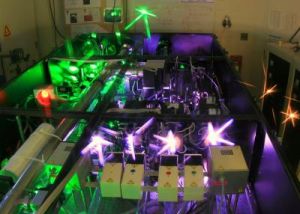
Posted by John Keller
Here's an eye-opener for a Sunday morning. Researchers at the University of Michigan demonstrated a 300-terawatt pulsed laser beam that lasts 30 femtoseconds.
That beam duration isn't long -- just 30 millionths of a billionth of a second -- but I have to wonder what this might mean for laser weapons. Compare this power with the Airborne Laser (ABL), which is designed to shoot down intercontinental ballistic missiles from the platform of a Boeing 747 jetliner.
The ABL is a "megawatt-class" laser, or power in the millions of Watts. This laser, I believe, can last longer than 30 femtoseconds; it takes a little longer than that to destroy a ballistic missile in flight, but consider the difference in power. The one at University of Michigan is terawatt-class.
"If you could hold a giant magnifying glass in space and focus all the sunlight shining toward Earth onto one grain of sand, that concentrated ray would approach the intensity of a new laser beam made in a University of Michigan laboratory," according to a story in PhysOrg.com entitled Michigan laser beam believed to set record for intensity. "'That's the instantaneous intensity we can produce,' said Karl Krushelnick, a physics and engineering professor. 'I don't know of another place in the universe that would have this intensity of light. We believe this is a record.'" Explains PhysOrg.com:
The record-setting beam measures 20 billion trillion Watts per square centimeter. It contains 300 terawatts of power. That's 300 times the capacity of the entire U.S. electricity grid. The laser beam's power is concentrated to a 1.3-micron speck about 100th the diameter of a human hair. A human hair is about 100 microns wide. This intensity is about two orders of magnitude higher than any other laser in the world can produce, said Victor Yanovsky, a research scientist in the U-M Department of Electrical Engineering and Computer Science who built the ultra-high power system over the past six years. The laser can produce this intense beam once every 10 seconds, whereas other powerful lasers can take an hour to recharge.
The university researchers envision putting this kind of laser to work in applications like proton and electron beams for radiation treatment of cancer, but I'm thinking about what kind of potential it holds for laser weapons. If there's anyone out there who has a good idea, please let me know in a comment below.
Harnessing this kind of power has to have the scientists at DARPA thinking. A detailed white paper about the experiment is online in .pdf format if you'd like to do a deep dive. I realize that the University of Michigan laser, an upgrade of the Hercules laser, is the size of several rooms, but the computer chip in your PC was once that size, too.
The accompanying photo shows the amplifier for the Hercules laser as it fires. The photo is by Anatoly Maksimchuk, associate research scientist in the Department of Electrical Engineering and Computer Science at University of Michigan in Ann Arbor, Mich.
For beam propagation in the atmosphere (the case for the Airborne Laser)there may be nonlinear optical effects for this pulsed laser which will severely limit the irradiance delivered to the target. It depends on the wavelength as well as the irradiance level and the pulse width. This pulsed laser may not be more effective than the current ABL COIL.
ReplyDeleteA note on the destructive power of this laser, and the comparison with the ABL:
ReplyDeleteIn order to destroy something (break, melt, evaporate, ...) a certain minimal amount of ENERGY is needed. For example, melting 1 kg of iron (and prior to that heating it up from room temp. to the melting point) requires an energy input of roughly 1 MJ (million Joule), which is about 0.3 kWh.
Energy is power times time (a low power lasting for a long time can give as much energy as a high power which lasts only a short time). The 300 terawatt of this Michigan laser is an enormous power (all due respect!), but if we multiply that power by 30 femtoseconds we get 10 Joule, which can melt only 10 milligrams of iron...
The ABL is a continuous wave laser (in contrast to pulsed). Its 1 Megawatt of power must last for 1 second in order to yield the 0.3 kWh of energy needed to melt 1 kg of iron.